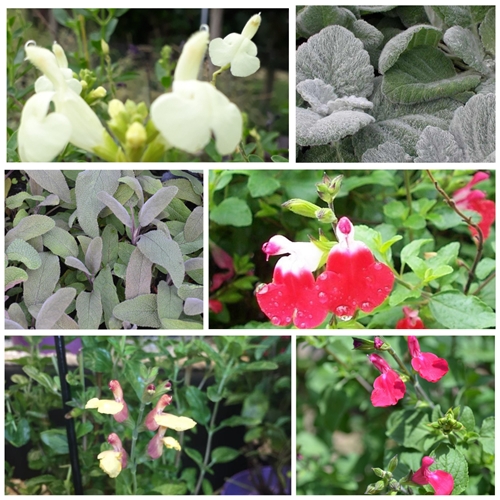
There are so many different salvias available to gardeners, the genus includes about 900 species known to Herb growers as "Sage" from the mother of them all Salvia officinalis, the green cooking sage for sage and onion stuffing.
Flowers are tubular with a lower split petal, colours vary from electric blue, bright red and lemon yellow, purple, white and there are great bi-colour versions such as 'Hot-lips'.
Foliage shapes and colours are also very varied but they all are scented when crushed. The Salvia covers many species from the Culinary edible sage to tender varieties which can be used as an annual in a bedding schemes or to fill a gap in the border.
There are many hardy herbaceous salvias such as the Shrub varieties 'Microphylla', 'Gregii', 'Jamensis' as well as the perennial varieties 'Argentea', the 'Wishes' series and everyone should have at least one in the garden but with such choice why not have many.
Where and How to Plant to your Salvia
All Salvias prefer full sun ideally south-facing and they will reward you with flowers lasting from mid-summer to the first frosts and they are loved by both bees and butterflies too. They are not particularly fussy about soil and will tolerate a fairly poor soil although they prefer clay. They will tolerate a coastal position and can deal with drought conditions once established.
Add plenty of grit to the hole when planting to improve drainage, being a Mediterranean plant they do not enjoy getting their feet wet in winter.
All Salvias can be grown in containers why not grow edible species near the kitchen in a pot nothing is quite like fresh sage in a stuffing or fry the leaves until crisp and scatter over a pork chop yum!
For more tender varieties its a great idea to grow in a pot as you can move the pot into the green house or conservatory before the first frosts to protect over winter. Keeping them on the dry side during winter.
Caring for your Salvia
Depending on the type of Salvia you have care will vary. Annual varieties will not overwinter you can try in the green house but generally it is best to buy new each year.
Hardy perennial types can be cut back hard in spring or autumn, all Salvias can become leggy if not pruned it really is essential to keep your plant looking at its best.
Half-hardy herbaceous are best pruned in Spring ideally after risk of frost had passed.
Shrub varieties may be pruned in September/October, reducing the shrub by 1/3rd and shaping to what you feel comfortable with. A further trim in Spring of any dead or damaged stems will result in a free flowering beautiful shrub. A further trim in May /June will produce a flush of growth and more flowers (cutting off the flowers at this time will benefit in the long term!!)
